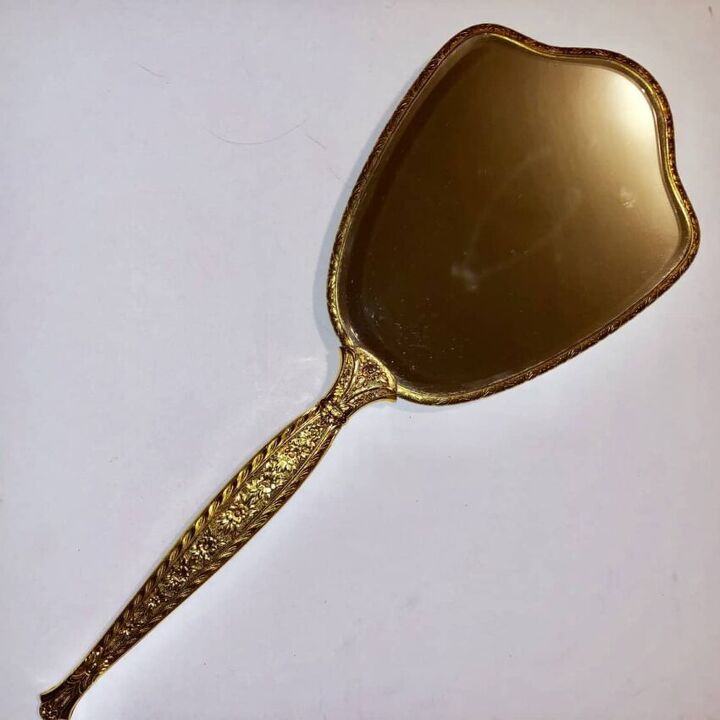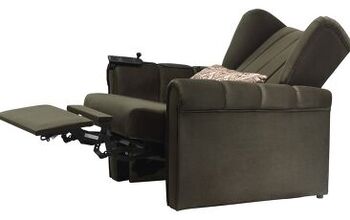8 Different Types of Antique Mirrors

Have you thought about wanting to find an antique mirror to keep in your home? Do you have a local thrift shop that you can score antique items? Growing up, some of us may have had the privilege of seeing a couple of these mirrors up close. As a child, my grandmother owned an antique handheld mirror and a vanity mirror tray.
It is great to see some of the antique designs that we may not have been able to view as children. If you’re wanting to bring a bit of history into your home, there are various styles of antique mirrors you may still be able to find today.
Need to dispose a mirror? Check out How To Dispose Of A Large Mirror.
History of Antique Mirrors
In the beginning, antique mirrors were called the ‘looking glass.’ Antique mirrors were first made in the early 16th century. They didn’t come over to England until the 17th century. Mirrors were first made by using the cylinder process, where there were blown, split open, and then laid flat by Sir Robert Mansell.
This process had its limitations so only single plates could be made at the time to make a single mirror. By the 18th century, larger mirrors were beginning to be made with better quality plates. This would then lead the way for more decorative mirrors to come about and make their way to Victorian homes.
Recycling
Did you know that years ago, they recycled antique mirrors? Recycling wasn’t a process that we only used today. Forms of recycling started in the 18th century. Since the English factories could not make large mirror plates, and there was heavy tax from abroad, it affected the development of mirrors being made in Britain. As a way to avoid tax, and bring in mirrors from France, they started to recycle old mirrors. Recycling old mirrors went on until the late 18th century until larger mirrors started to become developed with lighter frames.
At the start of the 19th century, the popularity of small antique mirrors came into place, such as the convex mirror. Convex mirrors were made for dining rooms, so butlers at the time could have a view of the dining room table to see when they would be needed at the dinner table.
The different types of antique mirrors to consider when browsing your local thrift store are handheld, floor-to-floor, toilet mirrors, vanity tray mirrors, Baroque, Georgian, Regency, and Rococo mirrors.
Different Types of Antique Mirrors
1. Handheld Antique Mirror
Towards the late 1800s, handheld mirrors became the item that everyone needed to have in every Victorian-styled home. A handheld mirror could be made out of hand-held cut glass set in silverplate, silver, or brass. In other countries, handheld mirrors that had porcelain backs became popular.
The Ancient Egyptians made mirrors out of metals like silver, bronze, and copper. Mirror-makers in the early times had the flattened sheet of speculum until they could see their reflection. Since handheld mirrors were so difficult to make, only the elite has possessed hand mirrors at the time.
The first glass mirror was introduced in Sidon, in Lebanon. The round mirrors were three inches in diameter and did not have a clear reflection. Hand mirrors started to become popular in Europe, as well as the Roman Empire.
2. Floor-To-Floor Antique Mirror
Above we have a Vintage floor-to-floor style antique mirror. This was a very popular option years ago when women would get ready in their Victorian homes. Floor mirrors were one of the most common types of mirrors and still are, so you can see yourself in full view. Floor mirrors can be labeled under three categories: traditional, leaning, and cheval.
3. Toilet Antique Mirror
Toilet mirrors were originally designed to be more of a decoration than to be put to use. Toilet mirrors were made around the late 1600s, and by the 1700s they were then developed into mirrors with bottom drawers.
4. Vanity Antique Mirror Tray
Vanity mirror trays were still popular even when I was growing up as a kid. I always remember this sitting on my grandmother’s vanity as she would get ready. Vanity tray mirrors were also known as the dresser try. A mirrored tray is a small tray with a mirror on the inside that was meant to hold the belongings of women such as perfumes, lotions, and brushes. These trays could also be used in dining rooms as the main decoration.
5. Baroque Antique Mirror
The Baroque-style antique mirror was made in the 17th century and had silver or gold gilding. Often you would find specific carvings in this mirror with designs such as flowers, leaves, fruits, and other angles.
6. Georgian Style Antique Mirror
Georgian-style antique mirrors were mirrors of the early 17 and mid-1800s. The Georgian-style mirror didn’t have as many carvings as other styles of antique mirrors did. The designs you could most find in this style were beading and scrolls.
7. Regency Antique Mirror
During the Regency time in the 1800s, Regency mirrors became popular and would come in oval or rectangular shapes. They often had flowers, columned framing, and cornice designs.
8. Rococo Antique Mirror
The Rococo-style antique mirror was popular from the mid 17 to early 1800s. With this style, you have sculpted frames that were gilded in gold. You would see items used such as birds, leaves, flowers, and seashells. The Rococo style was mostly oval or rectangular-shaped. These mirrors often had paintings on the back of them.
How To Determine The Age and Value Of Your Antique Mirror
If you already have an antique mirror in your home, or see one in a thrift store, you may be wondering just how old that mirror could be. Some antique mirrors are in perfect condition, while some may have normal wear or be more damaged. If you’ve had one in your home, you may have never thought about just how old it could be.
Believe it or not, there is a process to determining the correct age of antique mirrors. This requires the mirror to be physically inspected and researched, Get expert advice to determine the age and how much the mirror may be worth. In the majority of situations, there are similarities between the age and the value of a mirror. Mirrors that may have been constructed in the 20th century will not have the same price as a mirror that was handmade in the 1800s.
Determining when your mirror was made will be the first step at determining its value. Before you find answers, you’ll want to gather up as much information as you can.
1. Glass Check
Over time, the mercury on the back of a handmade mirror will break down and oxidize. This will give the mirror the appearance of random spots of cloudiness around the surface and edges. The color of the glass can also determine the age of the mirror. An older mirror might have a yellow or gray appearance.
If your mirror doesn’t have any color, this could mean the mirror is modern or the glass has already been replaced. In both cases, this can affect the value of the mirror.
2. Inspect The Back
The second thing you’ll want to do is inspect the back of the mirror. Most antique mirrors have a wood back, rather than paper. You’ll want to have the back examined to see if there are any nails or screws that identify in the period it was crafted.
Next, look at the fasteners in the mirror. Modern antique mirrors won’t have fasteners that look irregular. Finally, you’ll want to look on the back to see if the mirror has any tags to see if it has the location of where it was made.
3. Look At The Frame
The condition of the frame plays a very important part in determining the mirror’s age and value. You’ll want to see if the frame has any imperfections. As the mirror ages, it should show regular signs of normal wear and tear. Frames that old include metal, solid wood, or veneer wood.
Also, look at the frame to see if there any indications it was once repaired. If you notice an obvious or sloppy repair, this could decrease the value of the mirror.
Tips To Determine If Your Antique Mirror Is Fake
We’ve all been there. We go to a thrift store and find a beautiful piece of antique furniture that we must purchase. How do we tell if the piece is real or fake? There are many people out there who will go out of their way to try and replicate an antique mirror for profit. This is done by replacing the mirror, frame, and even the hardware. If you find yourself in a complicated situation of determining if your antique mirror is real or fake, here are some tips to help you along the way.
1. Browse Antique Sites
Check out any legit antique sites that have similar mirrors that you are trying to inspect. If you type in a specific name in your browser, you can get thousands, sometimes millions of search results. Look at any photos to determine the age and style of the mirror.
Once you have a good idea of the age and style of your antique mirror, use any descriptive keyword that might narrow down your search results. You can type in any of the styles we listed above such as toilet mirror, floor-to-floor, regency, etc.
In addition to determining your mirror’s value, antique sites will often use a description to describe mirrors. This description might include the mirror’s history and how old the mirror is. Search multiple antique sites along with auction sites for the best search results.
2. Appraisal Events
Not everyone may be able to attend an appraisal event. If you can, you may be able to find organizations, auction locations, and dealers that will give you a free appraisal of your item. If your location has it, you can contact your antique groups to see if your area has any events going on. If you want to get your item appraised, visit several dealers to get a few opinions before settling on one. You’ll want to make sure you’re not getting ripped on the value of your item.
3. Appraisal Hire
If you’ve made it this far, and you’ve determined your antique mirror could be of value, you’ll want to hire an appraiser. Having an antique appraiser will give your research credibility and value. A written appraisal will include descriptions, opinion of value, and for insurance purposes, replacement value.
If you hire an appraiser, they charge a flat or hourly fee. The downside to this is that an appraiser could cost you several hundred dollars depending on the amount of information that you need.
Where To Find Antique Mirrors
The value of an antique mirror will vary on condition, but antique mirrors can be found without burning a hole in your pocket. Where to find an antique mirror depends on your budget and the particular style that you’re looking for. You can find antique mirrors at thrift stores, flea markets, and even estate sales to find affordable mirrors.
Auctions are even a better way to find antique mirrors, although you might have to flexible with budget as some can get pricey depending on their age and value.
Antique stores and thrift stores offer the best selection of items that range from budget-friendly to high-cost items worth owning. You can buy antique mirrors on the internet. Although this option may be risky as you are not able to see the exact condition of the mirror, or if it’s in a legit sale. Always use caution when purchasing on the internet.
Final Thoughts
Antique micros come in many different shapes, sizes, and colors and can become a great unique addition to any household. Antique mirrors can complement any design scheme in your home, along with serving as a statement piece. Not only does it add style to a room, but it can also carry the history of craftsmanship and architectural style that was designed throughout the ages. Even with the imperfections that antique mirrors carry, there is a gorgeous antique item that can be incredible to own and pass down in your family.
Related Guide

I'm a stay at home mom of 2 who loves DIY projects! Since childhood I've always enjoyed to design and put personal touches on rooms around my home that fit my personality. When I'm not writing I'm doing DIY projects, as well as homeschooling and caring for my 2 children.
More by Nicole Abbott






















![10 Best Cordless Leaf Blowers – [2022 Reviews & Ultimate Guide]](https://cdn-fastly.upgradedhome.com/media/2023/07/31/9070789/10-best-cordless-leaf-blowers-2022-reviews-ultimate-guide.jpg?size=350x220)












